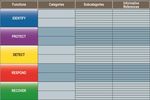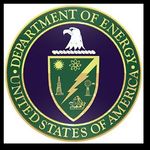Framework for Improving Critical Infrastructure Cybersecurity - Implementation of Executive Order 13636 - NIST
←
→
Page content transcription
If your browser does not render page correctly, please read the page content below
Framework for Improving Critical
Infrastructure Cybersecurity
Implementation of Executive Order 13636
19 February 2015
cyberframework@nist.govResources
Where to Learn More and Stay Current
The National Institute of Standards and Technology Web site is
available at http://www.nist.gov
NIST Computer Security Division Computer Security Resource
Center is available at http://csrc.nist.gov/
The Framework for Improving Critical Infrastructure Cybersecurity
and related news and information are available at
www.nist.gov/cyberframework
For additional Framework info and help cyberframework@nist.govNational Institute of Standards and Technology (NIST)
About NIST NIST Priority Research Areas
• Part of the U.S. Department of
Commerce Advanced Manufacturing
• NIST’s mission is to develop
and promote measurement, IT and Cybersecurity
standards, and technology to
enhance productivity, facilitate Healthcare
trade, and improve the quality
of life.
Forensic Science
• 3,000 employees
• 2,700 guest researchers Disaster Resilience
• 1,300 field staff in partner
organizations Cyber-physical Systems
• Two main locations: Advanced
Gaithersburg, MD and Communications
Boulder, CO
4The Role of NIST
• Role in cybersecurity began in 1972 with the development of the Data Encryption
Standard – began when commercial sector also has a legitimate need for
cryptography, including in ATMs.
• Charter for both public and private sectors
• Non-regulatory
• Using widely-accepted standards helps create competitive markets around market
need through combinations of price, quality, performance, and value to consumers. It
then promotes faster diffusion of these technologies throughout industry.
• Ensure timely availability of standards, and associated testing, that address
identified NIST IT Laboratory priorities, including national priorities established in
statute or administration policy;
• Achieve cost-efficient, timely and effective solutions to legitimate regulatory,
procurement and policy objectives;
• Promote standards and standardization systems that enable innovation and foster
US competitiveness; and
• Facilitate international trade and avoid the creation of unnecessary obstacles to
5
trade.Executive Order:
Improving Critical Infrastructure Cybersecurity
“It is the policy of the United States to enhance the security and resilience of
the Nation’s critical infrastructure and to maintain a cyber environment that
encourages efficiency, innovation, and economic prosperity while promoting
safety, security, business confidentiality, privacy, and civil liberties”
President Barack Obama
Executive Order 13636, Feb. 12, 2013
• The National Institute of Standards and Technology (NIST) was directed to
work with stakeholders to develop a voluntary framework for reducing cyber
risks to critical infrastructure
• Version 1.0 of the framework was released on Feb. 12, 2014, along with a
roadmap for future work
6Based on the Executive Order, the Cybersecurity
Framework Must
• Include a set of standards, methodologies, procedures, and
processes that align policy, business, and technological approaches
to address cyber risks
• Provide a prioritized, flexible, repeatable, performance-based, and
cost-effective approach, including information security measures
and controls, to help owners and operators of critical infrastructure
identify, assess, and manage cyber risk
• Identify areas for improvement to be addressed through future
collaboration with particular sectors and standards-developing
organizations
• Be consistent with voluntary international standards
7Development of the Framework
Ongoing Engagement:
Engage the EO 13636 Issued – February 12, 2013 Open public comment
Framework NIST Issues RFI – February 26, 2013 and review encouraged
Stakeholders
1st Framework Workshop – April 03, 2013 and promoted throughout
the process
Collect,
Categorize, Completed – April 08, 2013
cyberframework@nist.gov
and Post RFI Identify Common Practices/Themes – May 15, 2013
Responses
Analyze RFI 2nd Framework Workshop at CMU – May 2013
Responses Draft Outline of Preliminary Framework – June 2013
Identify 3rd Workshop at UCSD – July 2013
Framework
Elements 4th Workshop at UT Dallas – September 2013
Prepare and 5th Workshop at NC State – November 2013
Publish
Framework Published Framework – February 2014
8Framework Components
Aligns industry standards and Cybersecurity activities and
best practices to the Framework informative references,
Core in a particular organized around particular
implementation scenario outcomes
Supports prioritization and Framework Enables
Framework
measurement while Core communication of cyber
Profile
factoring in business risk across an
needs organization
Framework
Implementation
Tiers
Describes how cybersecurity
risk is managed by an organization
and degree the risk management
practices exhibit key characteristics
9Framework Core
What assets need protection?
What safeguards are
available?
What techniques can identify
incidents?
What techniques can contain
impacts of incidents?
What techniques can restore
capabilities?
10Framework Core Excerpt
11Framework Profile
• Alignment of Functions, Categories, and Subcategories
with business requirements, risk tolerance, and resources
of the organization
• Enables organizations to establish a roadmap for reducing
cybersecurity risk that is well aligned with organizational
and sector goals, considers legal/regulatory requirements
and industry best practices, and reflects risk management
priorities
• Can be used to describe current state or desired target
state of cybersecurity activities
12Framework from Executives to Operations
13Framework Implementation Tiers
• Feedback indicated the need for the Framework to allow for
flexibility in implementation and bring in concepts of maturity
models.
• Responding to feedback, Framework Implementation Tiers
were proposed to reflect how an organization implements
the Framework Core functions and manages its risk.
• The Tiers are progressive, ranging from Partial (Tier 1) to
Adaptive (Tier 4), with each Tier building on the previous
Tier.
• The Tier characteristics are defined at the organizational
level and are applied to the Framework Core to determine
how a category is implemented.
14Uses of the Cybersecurity Framework
The Framework is designed to complement existing business and
cybersecurity operations, and can be used to:
• Understand security status
• Establish / Improve a cybersecurity program
• Communicate cybersecurity requirements with stakeholders,
including partners and suppliers
• Identify opportunities for new or revised standards
• Identify tools and technologies to help organizations use the
Framework
• Integrate privacy and civil liberties considerations into a
cybersecurity program
15Why You Should Consider Adopting the Framework
Benefits Features
• Reduces time and expense • Organizes reconciliation and de-
of starting an information confliction of legislation, regulation,
security program policy, and industry best practice (Core)
• Reduces risk within current • Guides organization and management of
information security and information security program (Core)
programs by identifying • Measures current state and expresses
areas for improvement desired state (Profile)
• Increases efficiencies and • Enables investment decisions to address
reduce the possibility of gaps in current state (Profile)
miscommunication within • Communicates cybersecurity
your information security requirements with stakeholders,
program and with other including partners and suppliers (Profile)
organizations such as • Enables informed trade-off analysis of
partners, suppliers, expenditure versus risk (Tiers)
regulators, and auditors
16Key Points about the Cybersecurity Framework
• It’s a framework, not a prescription
• It provides a common language and systematic methodology for
managing cyber risk
• It does not tell a company how much cyber risk is tolerable, nor
does it claim to provide “the one and only” formula for
cybersecurity
• Having a common lexicon to enable action across a very diverse
set of stakeholders will enable the best practices of elite
companies to become standard practices for everyone
• The framework is a living document
• It is intended to be updated over time as stakeholders learn from
implementation, and as technology and risks change
• That’s one reason why the framework focuses on questions an
organization needs to ask itself to manage its risk. While
practices, technology, and standards will change over time—
principals will not
17Framework Roadmap Items
• The Executive Order calls for the framework to “identify areas for
improvement that should be addressed through future collaboration
with particular sectors and standards-developing organizations”
• High-priority areas for development, alignment, and collaboration
were identified based on stakeholder input:
• Authentication
• Automated Indicator Sharing
• Conformity Assessment
• Cybersecurity Workforce
• Data Analytics
• Federal Agency Cybersecurity Alignment
• International Aspects, Impacts, and Alignment
• Supply Chain Risk Management
• Technical Privacy Standards
18Since the 12 February 2014 Release of Framework 1.0
Request for Information: Experience with
the Cybersecurity Framework
Questions focused on: awareness, experiences, and
roadmap areas
6th Cybersecurity Framework
Workshop
Goal: Raise awareness, encourage use as a
tool, highlight examples of sector-specific efforts,
implementation efforts, gather feedback
Update on the Cybersecurity Framework
Summary posted that includes analysis of RFI
responses, feedback from the 6th workshop, an
update on Roadmap areas, and next steps
February 13, 2015 1 Year Anniversary of the Release
White House Releases Fact NIST Cybersecurity Framework site update to
Sheet on Cybersecurity and include: FAQs, Upcoming Events, and Industry
Consumer Protection Resources. Ongoing, targeted outreach continues
19Examples of Framework Industry Resources
The Cybersecurity Framework
in Action: An Intel Use Case
Cybersecurity Guidance
for Small Firms
Energy Sector Cybersecurity Framework
Implementation Guidance
Process Control System
Security Guidance for
the Water Sector
Other online communities of interest
20Near Term Framework Activities
In summary, “Collect, Reflect, and Connect” – understand where
industry is having success, help others understand those
successes, and facilitate relationships that support understanding
and use
• Continue education efforts, including creation of self-help and
re-use materials for those who are new to the Framework
• Continue awareness and outreach with an eye toward industry
communities who are still working toward basal Framework
knowledge and implementation
• Educate on the relationship between Framework and the larger
risk management process, including how organizations can
use Tiers
• To allow for adoption, Framework version 2.0 is not planned for
the near term
21Resources
Where to Learn More and Stay Current
The National Institute of Standards and Technology Web site is
available at http://www.nist.gov
NIST Computer Security Division Computer Security Resource
Center is available at http://csrc.nist.gov/
The Framework for Improving Critical Infrastructure Cybersecurity
and related news and information are available at
www.nist.gov/cyberframework
For additional Framework info and help cyberframework@nist.gov
Your presenter today was Matt Barrett, Cybersecurity Framework
Program Manager (matthew.barrett@nist.gov)You can also read






















































